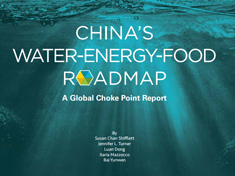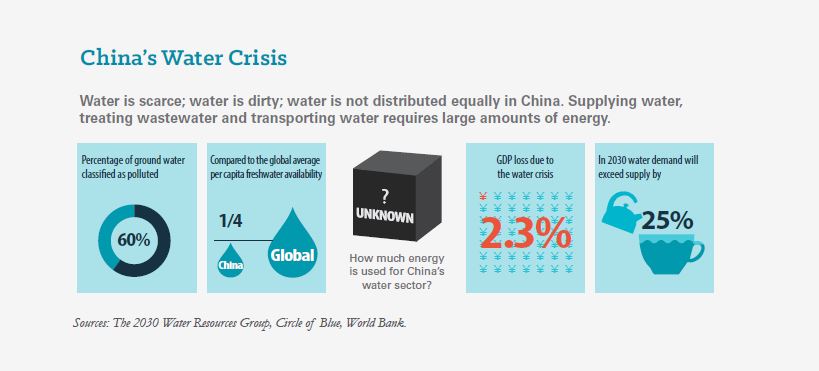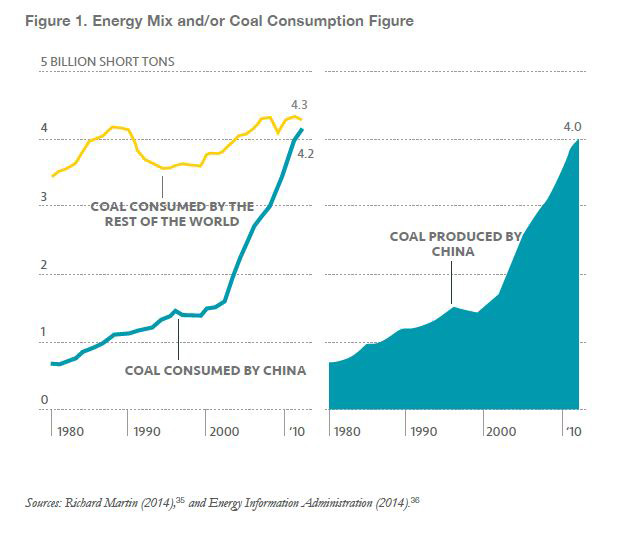-
China’s Water-Energy-Food Roadmap: A New Global Choke Point Report
March 30, 2015 By Susan Chan Shifflett
The creation of a water-energy research initiative in the landmark U.S.-China climate agreement last fall could be the beginning of a new and different path for Sino-U.S. collaboration.
The creation of a water-energy research initiative in the landmark U.S.-China climate agreement last fall could be the beginning of a new and different path for Sino-U.S. collaboration.
Progress in cleaning the air cannot be achieved without greater attention to resource interdependenciesRapidly growing demand for water, energy, and food is creating a massive choke point for China and the world. Energy development requires water. Moving and cleaning water requires energy. Food production at all stages – from irrigation to distribution – requires water and energy. While conversations about China’s environmental challenges are often dominated by coal, the culprit for the endless smoggy days in cities across the country, progress in cleaning the air cannot be achieved without greater attention to resource interdependencies from an integrated water-energy-food lens.
As the world’s manufacturing hub and most populous country, China demands all three resources in ever increasing amounts. Per-capita energy demand in China has risen five percent each year for the last decade. Meat consumption has quadrupled over the last 30 years. In 2030, water demand is expected to exceed supply by 25 percent. In the United States, the shale gas revolution, emergence of biofuels, and droughts in the west and southwest have brought more attention to the water-energy-food nexus. As the world’s top two greenhouse gas emitters, cooperation between the United States and China is a critical avenue for providing leadership on the stewardship of global resources.
In this new Global Choke Point report, “China’s Water-Energy-Food Roadmap,” the China Environment Forum examines interlinked water, energy, and food insecurities and proposes potential bilateral solutions for addressing them.
Where’s My Water?
Pressure on water is at the heart of resource constraints in China. The country’s power and agricultural sectors are competing for scarce supplies. Water availability per capita is only one-third the global average. As some 350 million more people move into urban areas over the next 15 years, groundwater around urban centers is being pumped faster than it can be naturally recharged and water levels are falling fast. Projected demand in 2030 – 818 billion m3 – is expected to outstrip supply, which currently amounts to 618 billion m3. Significant industrial and domestic wastewater pollution makes the “quality adjusted” supply-demand gap even greater.
Water for Energy, Energy for Water
Coal remains China’s main source of energy. According to the International Energy Agency, about 80 percent of the country’s power in 2013 was generated by coal. Initial research into coal’s “thirst” estimates between 11 and 20 percent of all water used in the country goes to coal mining, processing, coal ash control, and cooling of coal-fired power plants.
 The lifecycle of coal is water intensive around the world, however it presents a particular quandary for a country already facing a water scarcity crisis. Moreover, most water resources in China are in the south while much of the agricultural production and coal reserves are in the north.
The lifecycle of coal is water intensive around the world, however it presents a particular quandary for a country already facing a water scarcity crisis. Moreover, most water resources in China are in the south while much of the agricultural production and coal reserves are in the north.Water pollution is in turn placing pressure on China’s energy resources. As the government steps up its efforts to reduce water pollution from municipalities, industries, and agriculture, more wastewater treatment plants are needed, consuming even more energy.
While water efficiency is gaining traction as a policy priority, policymakers continue to emphasize supply-side solutions, such as building large and highly energy-intensive water transfers (e.g., the South-North Water Transfer Project) and desalination plants.
Adding Food to the Mix
China has the challenge of feeding 20 percent of the world’s population with only seven percent of its freshwater resources and less than 10 percent of the arable land. While often overlooked, the role food plays in the water-energy choke point must not be understated. At every step of the process, from irrigation to processing to distribution, food production requires large amounts of water and energy. Droughts, coupled with competition over water with cities and the power sector (especially coal plants), are reducing crop yields.
Moreover, as China becomes wealthier and more people adopt meat-rich diets, industrial farms specialized in animal husbandry are expanding. This to improve food security and raise rural incomes also requires larger amounts of water and energy. China’s agricultural sector now uses more than half the country’s water due to heavy reliance on irrigation and high levels of waste, and animal waste is often left untreated, leaching into soil and water and creating soil pollution and toxic algae blooms.
Finding Solutions in Connections
China is not alone in facing a water-energy-food confrontation. A historic three-year drought in the United States has hammered hydropower production in the west and forced California to rely more on natural gas, wind, and solar power. California’s agriculture has been pummeled; some farmers have been forced to shrink production, switch to less water-intensive crops, or simply stop farming altogether. Over the past decade, U.S. national laboratories, think tanks, universities, and NGOs have been at the forefront of global research on water-energy-food choke points, raising the issue on policy and business agendas. These developments could offer valuable insights on a possible path forward for China, while improving relations between the two powers.
The roadmap identifies three main areas for choke point research and policy development that are particularly promising for Sino-U.S. collaboration, whether via the new climate accord or other means:
- Identify the magnitude of water-energy-food issues. A top priority for Chinese researchers and policymakers should be to calculate the financial and environmental costs of water-energy-food interactions. Data needs to be collected not just nationally, but at provincial and municipal levels, as water resources vary significantly throughout the country. While the water footprint of energy has gained some recognition as an important development challenge, the energy footprint of water is often overlooked, generally because water is seen as a free or low-cost resource.
- Ramp up demand-side management practices and policies. In addition to mandated energy intensity reductions and water consumption limits, Chinese planners need to strengthen integrated approaches that look at the link between water and energy use, particularly in the construction and industrial sectors. Just as there can be a negative domino effect in the interlinked competition for water, energy, and food, there can also be a positive multiplier effect when all three are managed together. Energy efficiency reduces water use in the energy sector, for example, leaving more water available for food production and other sectors. Promoting less water-intensive crops and lowering food waste can help save significant amounts of water and energy. And incorporating the cost of water into electricity production and reforming energy pricing policies accordingly could be effective market tools to promote energy efficiency.
- Strengthen collaboration, particularly at the corporate and subnational levels. While some U.S. researchers, NGOs, and foundations are starting to address water-energy-food issues in China, the government and business communities in both countries have lagged behind. The new water-energy track under the climate accord led by the U.S.-China Clean Energy Research Center is a promising step forward and should be used as a launching point for more. Bilateral and multilateral institutional collaboration should continue to be integrated into existing energy and environmental programs. Moreover, because states, provinces, and cities in the United States are some of the most innovative in dealing with choke point constraints, local-to-local cooperation will be crucial. Finally, from a corporate perspective, the United States and China are significant markets for water and energy saving technologies, creating opportunities for joint technology development.
While there are no easy solutions to these water-energy-food issues, this roadmap aims to spark discussion and debate, empowering Chinese stakeholders and their partners to explore choke points in their own countries and abroad.
Sources: 2030 Water Resources Group, Bloomberg Business, The Economist, The Energy Collective, International Energy Agency, National Geographic, PBS NewsHour, World Bank, Xinhua.
Image Credit: China Environment Forum.
 A Publication of the Stimson Center.
A Publication of the Stimson Center.






